« “Up in Smoke” PostScript: Related Materials on Climate Change and LAC | Home | Tools: Environmental Atlas for the Capital of Tango »
Trash Photos IV: The Carioca Model
By Keith R | October 2, 2006
Topics: "Trash Photos" Series, Waste & Recycling | No Comments »
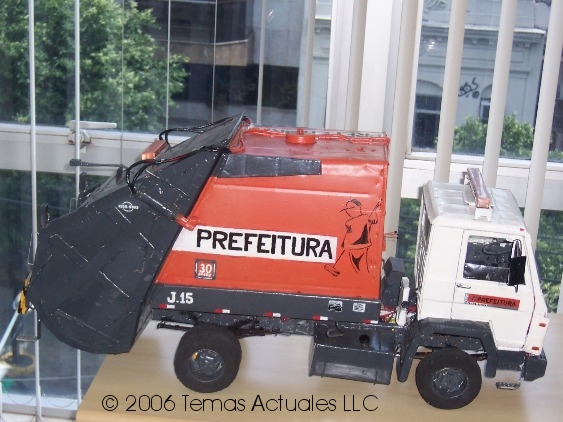
I took the above photo in the offices of Rio de Janeiro’s Municipal Urban Sanitation Company (Companhia Municipal de Limpeza Urbana – Comlurb) this past spring. Every year when in Rio I meet with a friend in Comlurb who is a well-known and well-informed waste expert. Sometimes we meet at Comlurb’s main office in Tijuca, as we did this year. I spotted this model truck on a stand behind my friend’s desk and just had to take a picture of it.
Why am I showing you this photo of a model Comlurb waste collection truck?
Because, ladies and gentlemen, it is was made entirely with recovered materials. Yup, more creative recycling. Which is somehow appropriate, given all the different experiments Comlurb has conducted over the years in waste recovery (something I intend to blog about in future entries).
 Another interesting thing about that model — to me, at least — is the prominence of the label “Prefeitura.” Prefeitura is the Portuguese word for “city hall” — the city executive, in other words. Until a few years back, everything associated with the Company featured its own acronym prominently. The joke in Rio is that City Hall, looking around for something to improve its own image, decided that everything associated with Comlurb needed to feature “Prefeitura” first and foremost, with the Comlurb name smaller and almost as a footnote. Borrowed prestige, as it were.
Another interesting thing about that model — to me, at least — is the prominence of the label “Prefeitura.” Prefeitura is the Portuguese word for “city hall” — the city executive, in other words. Until a few years back, everything associated with the Company featured its own acronym prominently. The joke in Rio is that City Hall, looking around for something to improve its own image, decided that everything associated with Comlurb needed to feature “Prefeitura” first and foremost, with the Comlurb name smaller and almost as a footnote. Borrowed prestige, as it were.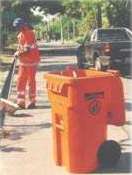
You see, although Comlurb the mixed-capital company was only created in 1976, it can trace its roots and reputation in Rio all the way back to the end of the 19th century. The ubiquitous men in orange (nicknamed “garis” after the Frenchman Aleixo Gary credited with starting formal municipal sanitation service in Rio in 1885-1895), and the orange canisters and bins, are Rio institutions trusted by cariocas. Given Rio’s size and population density, the number of concerts, conventions and events that Rio hosts, and the huge number of visitors that come to Rio every year, Comlurb does a pretty good job of keeping the city clean.
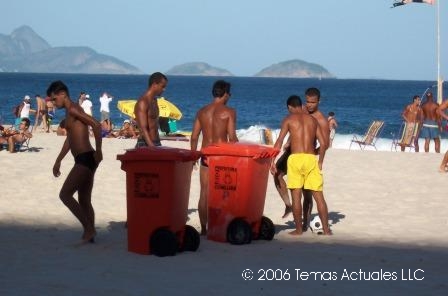
Even though they tied up four trash bins this way for quite awhile, there were still plenty of bins nearby for people to throw away their disposables, coconut husks, etc. And more importantly, those nearby bins were frequently checked and emptied by the men in orange. The nearby bins never became overstuffed or overflowing with trash.
I have been traveling to Rio since 1979, and have yet to see an overflowing Comlurb bin by the beach, in a city park, or by a tourist spot. There are many Latin American and Caribbean (LAC) cities and tourist spots, I am sorry to say, that could learn from that example.
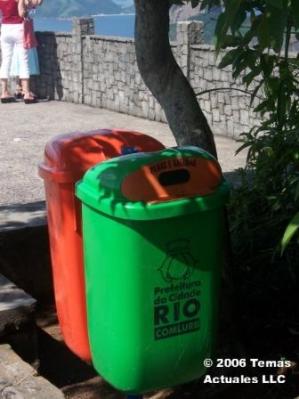
But look closer. The orange bin facing away is an ordinary rubbish bin. The green one facing the camera, however, says “pilhas e baterias.” It is for disposing of spent batteries.
Rio, you see, was one of the first municipalities in Brazil — for that matter, in Latin America — to set up a citywide collection system for spent batteries. In Rio you can spot hundreds of these green bins. You might not see any batteries inside them, but then, that’s a blog topic for another day.
Their experiments with special collection and recycling schemes do not stop with batteries, though (again, I’ll leave the details for a future blog). Check closely the label on the dark bin with orange top shown in this photo along the beach in Rio.
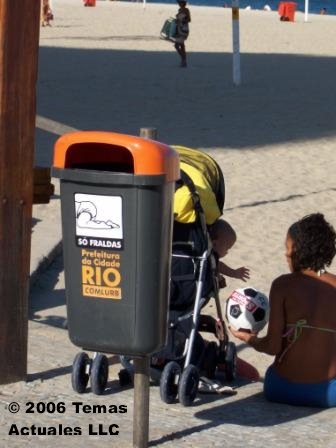
But then Comlurb, like the city it serves, is not like everyone else.
É certo, rapaz! Comlurb é carioca!
Tags: batteries, Comlurb, Copacabana, Corcovado, disposable diapers, garis, lixo, nappies, pilas, pilhas, reciclagem, recycling, residuos, Rio de Janeiro, saneamento, Sanitation, waste


